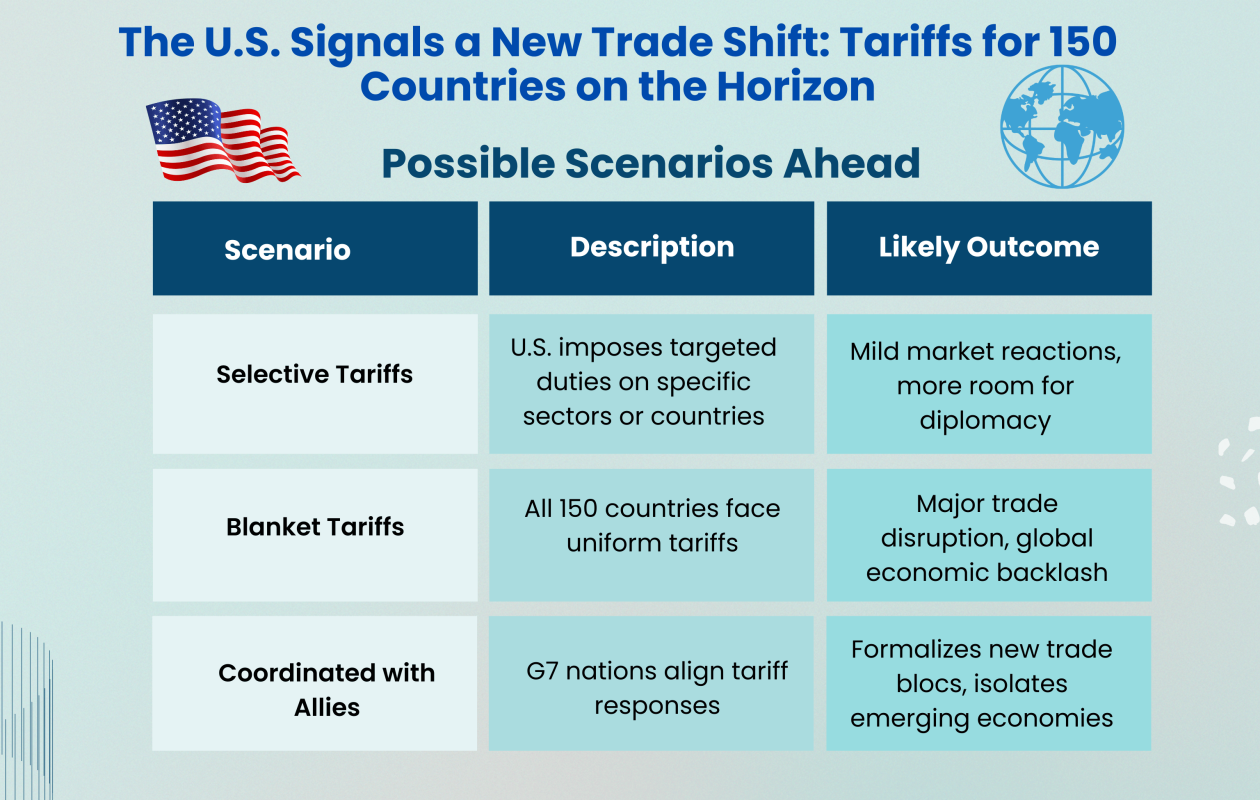In a bold move signaling a major shift in global trade policy, the United States has declared that it cannot negotiate trade terms individually with 150 countries within a 90-day timeframe. Instead, it plans to implement new tariffs for all of them in the coming weeks. This announcement reflects not only logistical realities but also a strategic recalibration of U.S. trade policy with significant global implications.
Why the U.S. Is Changing Its Approach
The U.S. government’s admission that it cannot manage 150 bilateral negotiations in 90 days is not just a matter of capacity — it represents a deeper strategic pivot. Rather than relying on traditional one-on-one trade talks, the U.S. is opting for unilateral, sweeping action. This may involve implementing uniform or semi-uniform tariff policies across a broad range of nations.
This approach indicates:
-
A shift from diplomacy to defense — protecting U.S. economic interests by acting swiftly and decisively.
-
A move toward simplifying enforcement against what the U.S. perceives as unfair trade practices.
-
An effort to rebalance global trade dynamics in favor of domestic industries, particularly in politically sensitive sectors.
A New Phase of Economic Nationalism?
This announcement is part of a broader movement toward economic nationalism, which includes:
-
Onshoring and nearshoring of supply chains to reduce dependence on foreign manufacturing.
-
Increasing investments in domestic production (e.g., semiconductors, EV batteries).
-
Creating “friend-shoring” networks with trusted allies while applying pressure to others.
By hinting at tariffs for 150 countries — which represent nearly 80% of global trade partners — the U.S. is signaling a potential Trade War 2.0, but on a much broader scale than the one with China in the late 2010s.
Implications for Global Trade
1. Global Supply Chain Disruption
Tariffs increase the cost of goods entering the U.S., which may lead to:
-
A ripple effect in global logistics, as exporters scramble to reconfigure routes and sourcing strategies.
-
Higher costs for U.S. importers and consumers.
-
Reduced trade flows, especially from smaller economies dependent on the U.S. market.
2. Decreased Predictability
Many countries — especially developing economies — rely on stable trade rules to plan production and investment. A sudden, sweeping tariff policy creates:
-
Uncertainty in long-term contracts.
-
Hesitation in foreign direct investment.
-
The potential for retaliatory tariffs, further escalating global tensions.
3. Geopolitical Realignment
This move could:
-
Strain relations with long-time allies who are suddenly hit with tariffs.
-
Force countries to pivot towards regional alliances (e.g., ASEAN, BRICS, African Union).
-
Accelerate the decoupling of East-West trade, leading to new global trade blocs.
Potential Impacts on Developing Countries (Including Vietnam)
While the U.S. may adopt differentiated tariffs, countries like Vietnam — which have enjoyed trade surpluses with the U.S. — must prepare for turbulence.
🔺 Risks:
-
Increased scrutiny of origin rules to prevent transshipment from China.
-
Possible inclusion in a generalized tariff regime if no bilateral exceptions are made.
-
Reduced competitiveness in price-sensitive sectors like textiles, furniture, and electronics.
✅ Opportunities:
-
If tariffs target advanced economies or non-compliant exporters, Vietnam may remain relatively safe — particularly if it:
-
Leverages trade agreements like CPTPP and EVFTA.
-
Proves transparent supply chains and compliance with U.S. regulations.
-
-
Vietnam could position itself as a “friendly sourcing alternative” amid U.S.-China decoupling.
Possible Scenarios Ahead

What Can Exporters and Policymakers Do?
For Exporters:
-
Diversify markets: Don’t rely solely on the U.S. — explore Europe, Middle East, Africa, and intra-Asia.
-
Ensure supply chain transparency: Use blockchain or digital tracking to verify origin and avoid accusations of Chinese transshipment.
-
Use FTAs effectively: Reduce tariffs through agreements like USMCA, CPTPP, or bilateral deals.
For Policymakers:
-
Proactively engage with USTR: Maintain open diplomatic lines to negotiate exceptions or clarifications.
-
Strengthen export compliance laws: Support businesses with origin audits, training, and digital certifications.
-
Build national brands: Shift from OEM (original equipment manufacturing) to branded exports that command price premiums.
Final Thoughts
This U.S. move to impose tariffs on 150 countries represents not only a logistical necessity but also a strategic reshaping of global trade. Countries and exporters that adapt swiftly, prove compliance, and diversify their risk will weather the storm — and potentially gain competitive advantages.
Trade is no longer just about price and logistics. It’s about strategy, sovereignty, and resilience.




 Tiếng Việt
Tiếng Việt